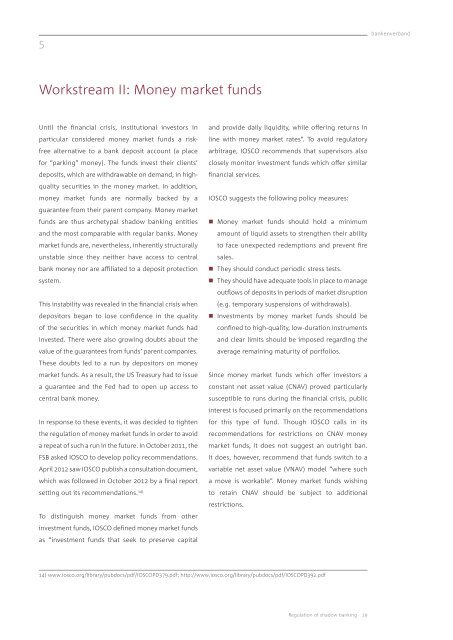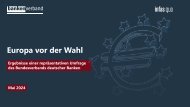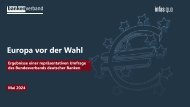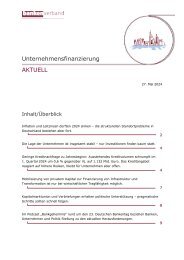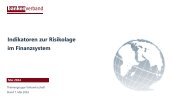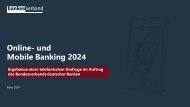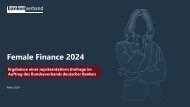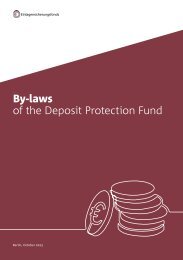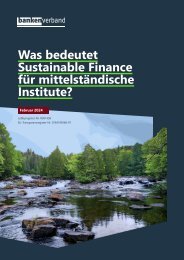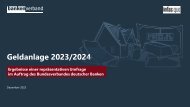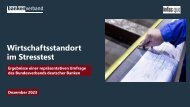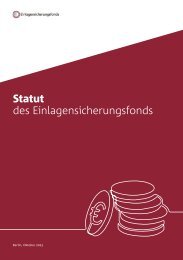Regulation of shadow banking
Shadow banking is given a large share of the blame for the financial crisis. This perception raises the question of what kind of shadow banking system should remain in place in the future.
Shadow banking is given a large share of the blame for the financial crisis. This perception raises the question of what kind of shadow banking system should remain in place in the future.
You also want an ePaper? Increase the reach of your titles
YUMPU automatically turns print PDFs into web optimized ePapers that Google loves.
5<br />
bankenverband<br />
Workstream II: Money market funds<br />
Until the financial crisis, institutional investors in<br />
particular considered money market funds a riskfree<br />
alternative to a bank deposit account (a place<br />
for “parking” money). The funds invest their clients’<br />
deposits, which are withdrawable on demand, in highquality<br />
securities in the money market. In addition,<br />
money market funds are normally backed by a<br />
guarantee from their parent company. Money market<br />
funds are thus archetypal <strong>shadow</strong> <strong>banking</strong> entities<br />
and the most comparable with regular banks. Money<br />
market funds are, nevertheless, inherently structurally<br />
unstable since they neither have access to central<br />
bank money nor are affiliated to a deposit protection<br />
system.<br />
This instability was revealed in the financial crisis when<br />
depositors began to lose confidence in the quality<br />
<strong>of</strong> the securities in which money market funds had<br />
invested. There were also growing doubts about the<br />
value <strong>of</strong> the guarantees from funds’ parent companies.<br />
These doubts led to a run by depositors on money<br />
market funds. As a result, the US Treasury had to issue<br />
a guarantee and the Fed had to open up access to<br />
central bank money.<br />
In response to these events, it was decided to tighten<br />
the regulation <strong>of</strong> money market funds in order to avoid<br />
a repeat <strong>of</strong> such a run in the future. In October 2011, the<br />
FSB asked IOSCO to develop policy recommendations.<br />
April 2012 saw IOSCO publish a consultation document,<br />
which was followed in October 2012 by a final report<br />
setting out its recommendations. 14)<br />
To distinguish money market funds from other<br />
investment funds, IOSCO defined money market funds<br />
as “investment funds that seek to preserve capital<br />
and provide daily liquidity, while <strong>of</strong>fering returns in<br />
line with money market rates”. To avoid regulatory<br />
arbitrage, IOSCO recommends that supervisors also<br />
closely monitor investment funds which <strong>of</strong>fer similar<br />
financial services.<br />
IOSCO suggests the following policy measures:<br />
• Money market funds should hold a minimum<br />
amount <strong>of</strong> liquid assets to strengthen their ability<br />
to face unexpected redemptions and prevent fire<br />
sales.<br />
• They should conduct periodic stress tests.<br />
• They should have adequate tools in place to manage<br />
outflows <strong>of</strong> deposits in periods <strong>of</strong> market disruption<br />
(e.g. temporary suspensions <strong>of</strong> withdrawals).<br />
• Investments by money market funds should be<br />
confined to high-quality, low-duration instruments<br />
and clear limits should be imposed regarding the<br />
average remaining maturity <strong>of</strong> portfolios.<br />
Since money market funds which <strong>of</strong>fer investors a<br />
constant net asset value (CNAV) proved particularly<br />
susceptible to runs during the financial crisis, public<br />
interest is focused primarily on the recommendations<br />
for this type <strong>of</strong> fund. Though IOSCO calls in its<br />
recommendations for restrictions on CNAV money<br />
market funds, it does not suggest an outright ban.<br />
It does, however, recommend that funds switch to a<br />
variable net asset value (VNAV) model “where such<br />
a move is workable”. Money market funds wishing<br />
to retain CNAV should be subject to additional<br />
restrictions.<br />
14) www.iosco.org/library/pubdocs/pdf/IOSCOPD379.pdf; http://www.iosco.org/library/pubdocs/pdf/IOSCOPD392.pdf<br />
<strong>Regulation</strong> <strong>of</strong> <strong>shadow</strong> <strong>banking</strong> 19


